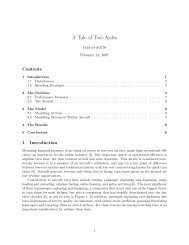Neural Models of Bayesian Belief Propagation Rajesh ... - Washington
Neural Models of Bayesian Belief Propagation Rajesh ... - Washington
Neural Models of Bayesian Belief Propagation Rajesh ... - Washington
Create successful ePaper yourself
Turn your PDF publications into a flip-book with our unique Google optimized e-Paper software.
11.3 <strong>Neural</strong> Implementations <strong>of</strong> <strong>Belief</strong> <strong>Propagation</strong> 243<br />
11.3.3 Inference Using Noisy Spiking Neurons<br />
Spiking Neuron Model<br />
The models above were based on firing rates <strong>of</strong> neurons, but a slight modification<br />
allows an interpretation in terms <strong>of</strong> noisy spiking neurons. Consider a<br />
variant <strong>of</strong> equation (11.16) where v represents the membrane potential values<br />
<strong>of</strong> neurons rather than their firing rates. We then obtain the classic equation describing<br />
the dynamics <strong>of</strong> the membrane potential vi <strong>of</strong> neuron i in a recurrent<br />
network <strong>of</strong> leaky integrate-and-fire neurons:<br />
τ dvi<br />
dt = −vi + <br />
wijIj + <br />
uijv ′ j, (11.29)<br />
j<br />
j<br />
where τ is the membrane time constant, Ij denotes the synaptic current due<br />
to input neuron j, wij represents the strength <strong>of</strong> the synapse from input j to<br />
recurrent neuron i, v ′ j denotes the synaptic current due to recurrent neuron j,<br />
and uij represents the corresponding synaptic strength. If vi crosses a threshold<br />
T , the neuron fires a spike and vi is reset to the potential vreset. Equation (11.29)<br />
can be rewritten in discrete form as:<br />
vi(t + 1) = vi(t) + ɛ(−vi(t) + <br />
wijIj(t)) + <br />
uijv ′ j(t)) (11.30)<br />
i.e. vi(t + 1) = ɛ <br />
wijIj(t) + <br />
Uijv ′ j(t), (11.31)<br />
j<br />
where ɛ is the integration rate, Uii = 1 + ɛ(uii − 1) and for i = j, Uij = ɛuij.<br />
The nonlinear variant <strong>of</strong> the above equation that includes dendritic filtering <strong>of</strong><br />
input currents in the dynamics <strong>of</strong> the membrane potential is given by:<br />
vi(t + 1) = f <br />
wijIj(t) + g <br />
Uijv ′ j(t) , (11.32)<br />
j<br />
j<br />
where f and g are nonlinear dendritic filtering functions for feedforward and<br />
recurrent inputs.<br />
We can model the effects <strong>of</strong> background inputs and the random openings <strong>of</strong><br />
membrane channels by adding a Gaussian white noise term to the right-hand<br />
side <strong>of</strong> equations (11.31) and (11.32). This makes the spiking <strong>of</strong> neurons in<br />
the recurrent network stochastic. Plesser and Gerstner [27] and Gerstner [11]<br />
have shown that under reasonable assumptions, the probability <strong>of</strong> spiking in<br />
such noisy neurons can be approximated by an “escape function” (or hazard<br />
function) that depends only on the distance between the (noise-free) membrane<br />
potential vi and the threshold T . Several different escape functions were found<br />
to yield similar results. We use the following exponential function suggested<br />
in [11] for noisy integrate-and-fire networks:<br />
j<br />
P (neuron i spikes at time t) = ke (vi(t)−T ) , (11.33)<br />
where k is an arbitrary constant. We use a model that combines equations<br />
(11.32) and (11.33) to generate spikes.<br />
j<br />
j
















